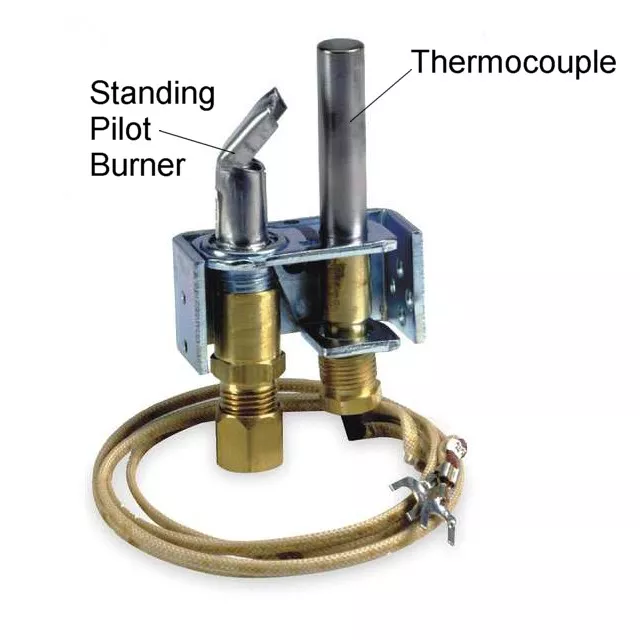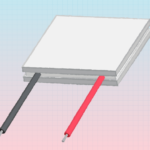Part 1 of this FAQ looked at the principles and components of a basic TEG system. Part 2 looks at some applications ranging from very small to large, and from scavenged auxiliary to primary power.
Q: It seems like TEGs are costly and complicated, despite the simple principle of operation. Is this the case?
A: No, they can be low cost and mass market sources, such as in the standard gas-fired water heater in widespread use for many decades.
Q: What does a gas-fired heater have to do with TEGs?
A: There are two classes of gas-fired heater: the newer ones with an electric ignitor which ignites the main burner when heat is needed; and the older, still very available ones which have no external electrical connection or battery, but instead use a pilot light to ignite the burner.
Q: So what’s the problem?
A: When the all-mechanical, bimetallic-strip thermostat indicate that the water in the tank has cooled down and thus needs to be heated, it could just open the gas valve for the burner and have the pilot light ignite it. But what if the pilot light has gone out, for whatever reason? Then the area will soon be filled with explosive gas, so some sort of safety lock-out is needed.
Q: So, what’s the solution?
A: A minimal version of an energy-harvesting TEG is used. A small thermocouple sits in the pilot-light flame, and the flame’s modest heat develops a thermocouple output of about 75 mV, Figure 1. This voltage drives a sensitive solenoid-controlled valve which allows gas to flow. If the pilot light is “out” for any reason, the valve will not open and the main gas flow is blocked. It’s simple, low cost, reliable, long lasting, and if it fails, it fails such that the valve is not driven and stays shut (having no hot water is better than having a basement filling up with gas!).

Q: OK, that’s a mass market application. What’s at the other extreme?
A: A special form of TEG called a radioisotope power generator (RPG) has been used in spacecraft for over 50 years. Although we usually assume they use large solar panels for power (they show up in the photos), that solution won’t work for vehicles which are traveling far from Earth (such as to Mars and far beyond) or in Earth’s shadow,
Q: How does an RPG work?
A: The principle is simple: a “battery” is built using a core of radioactive material (usually plutonium-238 isotope) surrounded by an array of dozens of thermocouples. As the material decays, the resultant decay heat reaches the thermocouples. This arrangement is very reliable for long-term performance. Since it is based on plutonium and intended for very long-term use, the design and fabrication are critical. The references provide more internal details.
Q: What’s an example of the use of RPGs?
A: It’s not widely known, but they were used in addition to fuel cells on the Apollo moon-landing missions — as solar cells were structurally impractical — and for long-term data loggers left on the moon. They have also been used in nearly every spacecraft which has left Earth orbit. But the best testament to their performance has been their use on the paired Voyager 1 and Voyager 2 missions to the edge of the solar system and beyond, both launched in 1977. The spacecraft are still sailing on, and their initial battery power of about 500 W and decreasing by about four watts per year (due to half-life decay). But they are still providing all primary power to the craft, which are over 10 billion miles from earth and still sending back periodical bursts of scientific data.
Q: How is an RPG constructed?
A; The Voyager probes are powered using heat from the decay of plutonium-238 in a trio of radioisotope thermal generators (RTGs) at the core of nine radioisotope heater units (RHUs) which capture this heat and convert it to electrical energy via an array of thermocouples, Figure 2. Each RHU contains a Pu-238 fuel pellet about the size of a pencil eraser and outputs about 1 W of heat; the entire RHU is about the size of a C-cell battery.

Q: Are there other down-to-Earth examples which illustrate TEG applications?
A: Of course. You can buy camping stoves which also extract some of the energy from the campfire, such as the CampStove-2 from BioLite, Figure 3. This power can be used in two ways: to power a small integral fan, thus increasing draft and fire’s heat output (note that the gain in heat output is greater than the heat absorbed by the TEG element, so it’s a net energy gain); or to drive a built-in USB charger for a smartphone or locator beacon (very handy if you are out in the wilderness).

This unit provides up to a modest 3 W peak power, and it stores accumulated fire-sourced TEG energy in a 2.6 A-hr battery which can be used to deliver 5V at 2A via the USB port. The key fact to keep in mind is that is that it can accumulate this energy over a period of time, then delivers it as power at higher current from the battery (power is the time-derivative rate of energy use, while energy is the time integral of power) Although 3 W is a small amount of power, it may be enough to charger a phone and make a difference.
Q: What about larger fire-based units?
A: Units are available which fit into or against fireplaces and larger stoves, such as this 100-W system from Devil Watt/TEGPro, which come with a cable that supplies up to 24 VDC for charging batteries, Figure 4. Keep in mind that generating 100 W takes a substantial amount of heat energy given the relatively low efficiency of TEG units. But if that heat is otherwise going “up the chimney” but can be accessed, this sort of unit may be a worthwhile enhancement.

Q: What about some industrial type of energy scavenging, which is sometimes called cogeneration?
A: There are companies which make TEG units which are placed around hot areas of engines or their cooling radiators (difficult to fit, but a good heat source). It is also commonplace to place the TEG core in the exhaust manifold of an engine (steam or internal combustion) to harvest some of that waste heat. Although the resultant gain is small – on the order of a 2-3% efficiency gain – that can be substantial and significant on a large engine. (Of course, that has to be compared against the cost of the scavenging system including electronics to transform that energy to useful power via DC/DC or DC/AC converters, as well as optional batteries.)
This FAQ has explored the interesting and often unseen world of thermoelectric generation which uses a classic physics principal in new ways, to capture and deliver power harvested from something as basic and primal as a campfire to providing a primary power source for leading-edge deep-space probes.
References
Thermocouples, Seebeck Effect, and Gas Heaters
- The Spruce (Dotdash Publishing), “How to Light the Standing Pilot on a Gas Furnace”
- Stack Exchange, “How does a gas water heater thermostat and gas valve work?”
- EEWorld Online, “Making sense of thermocouples and interfaces (part 1)”
- EEWorld Online, “Making sense of thermocouples and interfaces (part 2)”
- EEWorld Online, “Solenoids and relays, Part 1”
RTGs
- NASA, “Power and Thermal Systems (Future)”
- NASA, “What is Radioisotope Power and why does NASA use it?”
- NASA, “Power and Thermal Systems (Current)”
- Northwestern University, “What are radioisotope thermoelectric generators?”
- Space Safety Magazine, “Safety of Nuclear Powered Missions”
- Stanford University, “An Overview of Radioisotope Thermoelectric Generators”
- Stanford University, “Radioisotope Thermoelectric Generators (RTGs)”
Peltier Effect
- EEWorld Online, “How to specify the proper Peltier module for your design”
- University of Illinois, “Q & A: How can the Peltier effect work?”
- Elsevier/Science Direct, “Peltier Effect”
TEGs
- TEGmart, “Guide to Understanding and Using TEG Power and Products”
- TECTEG MFR, “How Thermoelectric TEG Generators Work”
- Stanford University, “A 1 KW Thermoelectric Generator for Low-temperature Geothermal Resources”
- ResearchGate, “Power and Efficiency Calculation in Commercial TEG and Application in Wasted Heat Recovery in Automobile”
- Arvix, “Efficiency calculation of thermoelectric generator using temperature dependent material’s properties”
- MDPI, “Enhanced Efficiency of Thermoelectric Generator by Optimizing Mechanical and Electrical Structures”





Leave a Reply